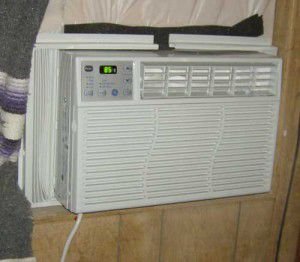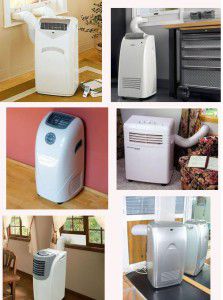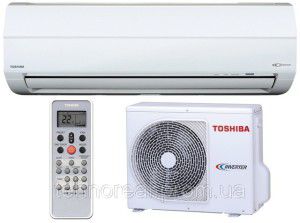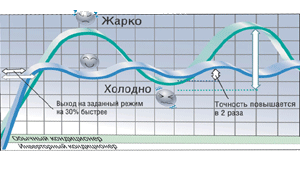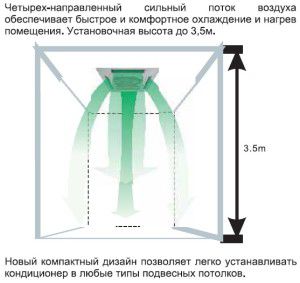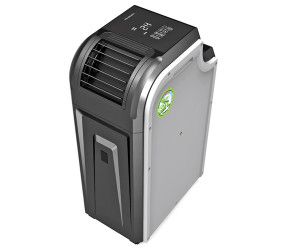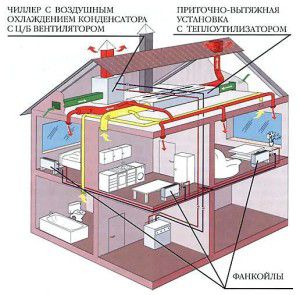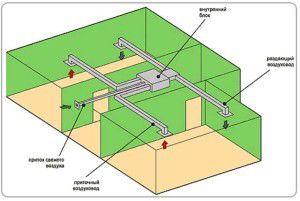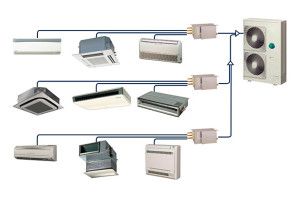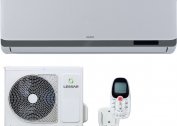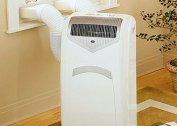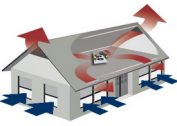There is a huge number of air conditioning systems for apartments and private houses, which can not only cool and create the necessary air mobility, but also heat the room, and if necessary add fresh tributaries from the street. The modern chiller is equipped with convenient user functions and reliable automation, which helps to create additional comfort in the air-conditioned area.
Among the proposed variety, it is easy to get lost, so when buying climate equipment it is worthwhile to figure out what types of air conditioners for the house and apartment exist, and how to choose the right climate equipment in your home.
Air conditioners for city apartments
Residential and semi-industrial refrigeration systems are usually installed in apartments: window and mobile monoblocks, as well as split systems, which, due to their structural and design features, can solve almost any air-conditioning problem in rooms from 15 to several hundred square meters.
Mobile and window units of air conditioners
With a limited budget for small residential areas, window or mobile air conditioners are purchased, which are a monoblock design with all the main work units in one building. Due to the fact that the compressor and fan are not placed in a separate unit, these devices operate more noisily than stationary split systems.
The difference in sound level is very noticeable. If we compare the wall split and mobile air conditioning with the same power in the cold of 2.5 kW, then the first device on average has only about 28-32 dB, and the second - 50-56 dB.
It is precisely because of noise that monoblocks are more often installed in areas where regular silence is not required: in the kitchen, in the living room, dining room, and office.
When installing the window unit, part of the double-glazed window is removed and a cooling device is inserted into the opening. Modern models no longer scare the consumer with their enormous dimensions and, unlike Soviet air conditioners for the home, they can function not only for cooling, but also for heating. Most of them have a standard range of working temperatures from -5 to + 43 ° C, but some brands, for example, WHITE-WESTINGHOUSE, produce devices that can work properly at -20 ° C due to the built-in heater.
The window unit is controlled by the remote control, and for manual control some models have not rotary mechanisms, but touch buttons. The presence of coal, plasma or bio-filters in this type of home air conditioner is not an innovation, and almost every window candy bar has the following functions:
- on / off timer;
- night sleep mode;
- hot start;
- cooling in turbo mode;
- self-diagnosis of malfunctions.
Their main advantage is the presence of a forced ventilation mode, with which you can ventilate the room.
In Russia, several manufacturers of window air conditioners with an average price range have proven themselves well:
- WESTINGHOUSE GENERAL ELECTRIC;
- Toshiba;
- Panasonic;
- GENERAL CLIMATE;
- TIMBERK.
Despite the growing popularity of split systems, window monoblocks are still in demand by customers in the climate technology market due to the ease of installation and lower cost.
If the question arises, which air conditioner to choose for a home in a room of up to 35 m², then, judging by customer reviews, mobile units will be a good alternative to the previous type of household air conditioners.
They also have a higher noise level in comparison with splits, but they cope with their task of air conditioning perfectly. Externally, this device looks like a box on wheels. Compressor, fan, evaporator and condenser - all operating elements are assembled in one housing.
You can choose a mobile air conditioner for the home, working both for cold and cold / heat. The standard set of modes also includes drainage and ventilation. Most have several fan speeds and the ability to control them. Key advanced features include:
- automatic mode selection;
- self-diagnosis of malfunctions;
- on / off timer;
- night sleep mode;
- protection against breakage during power surges and power outages;
- high-quality filtration system.
The mobile unit is controlled using the remote control or from the front panel. Some models are equipped with an LCD display for displaying current information on the user's review.
By the way, heating a house with a mobile type air conditioner is quite possible, since it has a built-in heating element, but the electricity consumption will be high, so this approach to generating heat is unlikely to pay off.
The disadvantage of a mobile candy bar, in addition to noise, is the need to remove hot air through a corrugated sleeve that is pulled out the window, balcony door, ventilation hood or basement. The average diameter of such a corrugated pipe is 10-12 cm, and its length is 1.5 meters, which clearly does not add sophistication to the design of the room.
During installation, it is necessary to maintain tightness at the joints of the hose and the outlet opening, otherwise, due to heat inflows, the work efficiency will significantly decrease.
If the noise from the operation of the mobile unit is very annoying, then you can purchase a mobile split system with an outdoor unit - a noisy compressor is just brought into it. It is mounted on special belts or brackets. There are models that work on heating either due to freon or an electric heater.
But it is much easier to use the mobility of the device with an air conditioner without an outdoor unit. It will be possible not only to move it around the room, but also to carry it to the country house or take it to a new place of residence. The outdoor unit significantly limits these actions, since the indoor unit can ride on wheels only within a small area.
The advantages of mobile air conditioners are their portability, ease of installation and lower price than a split system.
The most popular manufacturers of these climatic units of equipment in Russia consider:
- ELECTROLUX;
- BALLU;
- NEOCLIMA;
- ZANUSSI;
- GENERAL CLIMATE;
- DANTEX;
- AERONIC.
But no matter how modern and thought-out all-in-one devices are, for conditioning in a private house or apartment, none of them will surpass in its technical characteristics and functional set of split systems.
Split air conditioning systems for apartments and houses
In a split system, separation is meant into two blocks - internal and external. The compressor, fan, and heat exchanger (condenser) are located in the outside, and the tangential fan, heat exchanger (evaporator), filtration system, and other smaller working elements are located in the room. Both units have a freon connecting line, which is covered with insulation from above, and electrical wiring.
There are models with linear compressor control, the so-called on / off air conditioners, in which, when the set temperature is reached, the compressor is switched off, and inverter-controlled devices. These are distinguished by smooth power control, in which the compressor does not stop when the desired temperature is reached, but simply slows down. This significantly saves not only electricity, but also the resources of the air conditioner itself.Such devices are less noisy during operation.
All inverter devices in the indoor unit have an electronic control board responsible for adjusting the operation.
The most often bought for household purposes are wall split systems, since the dimensions of air conditioners for this type of house are very diverse. This allows you to install them in different rooms in different variations with respect to windows, furniture, heat sources and the main places of stay of people.
Wall systems exhibit excellent performance:
- low noise level;
- high energy efficiency;
- wide range of operating temperatures;
- purification of air from small impurities of dust and dirt;
- rapid cooling or heating of the room.
They have many convenient functions such as night mode of energy consumption, automatic adjustment of the shutters, motion sensors, in which the flows are distributed so that a person will never get under a direct stream of chilled air.
There are models that work exclusively in the cold, but now they mainly produce wall units that operate in the heat pump mode. The temperature range, of course, is not expanded for everyone and has relatively average indicators - from -5 to + 43 ° C, but the leaders of the climate industry, such as DAIKIN or MITSUBISHI ELECTRIC, produce whole series of splits with the ability to work in winter time to -25 ° C on the street, and not only in the cold, but also in the heat. Therefore, heating the house with a wall-mounted air conditioner with such parameters can very well be carried out.
It is worth remembering that split systems only recycle and cool the air in the room, and not update it. Partial or complete air changes can be arranged using semi-industrial duct type air conditioners with air ducts and a supply unit.
The only drawback of wall-mounted devices is the cooling capacity limitations. The most powerful of them can efficiently process indoor air up to 70 m², while the ceilings should be no higher than 3 meters, otherwise the air-conditioning efficiency is significantly reduced due to the fact that the air simply does not reach the lower zone.
What other air conditioners are there for the home, if you need, for example, more power, or are there restrictions due to the special configuration of the room?
Split system air conditioners are divided into:
- cassette
- channel;
- columned;
- floor and ceiling.
Some manufacturers can still meet separately only ceiling and only wall.
All these devices already belong to semi-industrial climate equipment, although they can provide air conditioning in a private house or a spacious apartment.
Ducted indoor units of split systems are integrated in suspended ceiling structures or in false walls. Only decorative grilles are visible on the surface. These devices are distinguished by their neat dimensions and greater power - they are able to process rooms up to 200 m² and have a cooling capacity of 5 to 20 kW.
The advantage of a channel air conditioner is the ability to organize cooling / heating of several rooms. The indoor unit itself can be hidden in the non-residential area (bathroom, corridor, pantry), but through the air ducts passing from it in different directions, the flows will go to all the necessary places.
Management takes place with the remote control. A set of additional functions does not differ from the functionality of wall systems.
The channel system has one significant minus - in all zones you can set only one temperature. This is inconvenient, as the cooling needs of, for example, kitchens and bedrooms are very different.
Cassette units are built into the cell of the suspended ceiling.Air passes through the distribution grilles and spreads in several directions - volumetric cooling or heating is obtained. They are also controlled by the remote control and have many different settings, including automatic ones. You can find models with power from 2.5 to 18-20 kW.
Although specifically for an ordinary apartment, a cassette split system is of little use. It is often installed in two-level apartments on the second level, where there are through openings between floors. The air disperses evenly over the entire area, without forming temperature imbalances at different points in the home.
One of the main conditions for installing a cassette or channel unit is a ceiling height of 3 meters.
Less often, floor-to-ceiling air conditioners with a capacity of 2.5 to 15 kW are installed in apartments. They have two installation options: just above the floor on the wall and on the ceiling. Some people believe that if necessary it will be possible to change the location of the indoor unit, but this is an erroneous opinion. It is mounted either in the floor version or in the ceiling.
The main advantage of such models is the distribution of air along the walls or ceiling. This helps to cover all inaccessible places in the room. The round, elongated rectangular, oval shapes of the rooms are perfectly air-conditioned by them.
They do not install columned air conditioners in the apartments, since they take up a lot of space and have very high cold performance, which is not required in residential areas. In addition, they are distinguished by powerful blowing, which becomes a constant cause of the common cold of residents.
Rules for choosing an air conditioner
Knowing what types of air conditioners are for a house with medium-sized rooms, you can move on to the rules for selecting a refrigeration device in an apartment.
Cooling capacity. First of all, the necessary cooling capacity of the device is always calculated. On average, 1 kW is taken for 10 m². If the room is located on the sunny side, on the top floor, it has a lot of working household appliances and constantly residing people, then they take another 20-30% into the reserve.
For example, for a room of 20 m² you can take an air conditioner model corresponding to a power size of 7 or 9. In the presence of large heat influxes, they prefer the ninth size.
Cold or cold / heat. Whether the air conditioner with the function of heating the house is needed, the buyer decides, given what time of year he will use it. If heat is required only in the off-season, the choice of models operating in the heat pump mode is very extensive. But their limit is outside temperature around -5 ° C.
To operate the device in cold weather, a special low-temperature kit is installed in it or an air conditioner with an already built-in winter kit is purchased.
Availability of additional features. Not always the user needs all the modern functions of the device. When choosing an air conditioner for your home, you should consider whether you need such “bells and whistles” as a multi-stage filtration system, automatic adjustment of dampers, motion sensors and drainage of the heat exchanger.
Inverter or start-stop. If the question arises of how to choose the right air conditioner for the home, so that it is used most of the day, then you should pay attention to inverter models that regulate the compressor power and save electricity consumption.
Noise. How to choose a home air conditioner so that it does not interfere not only with users, but also with neighbors? Be sure to look at the noise level (min / max) of both units. Values of 30-35 dB are comparable to a quiet conversation. Noise more than 40 dB at night can disturb sensitive people.
Type of indoor unit. Sometimes there is no way to find excess space in a room on the floor or on the wall. In this case, the channel or floor-to-ceiling (ceiling) air conditioning will become a way out.
If the shape of the room is not quite standard, then the floor-ceiling model or wall split with a vertical indoor unit will help out. Their blowing goes along the wall.
In this case, attention is also paid to the ceiling height - up to 3 meters, wall-mounted split-system models and monoblock devices will completely cope with their tasks.
The size of the indoor unit. An important factor when buying is the dimensions of the air conditioner for the home, because you can hang a model with any width of the indoor unit on the free wall, which corresponds to the power of the selected size. If the installation will be carried out between windows or in another limited space, then a series of mini-air conditioners for the house with compact internal modules are suitable.
Almost every manufacturer has such lines. For example, MITSUBISHI, LG, PANASONIC, Venterra, MDV they produce split systems of wall and channel types with reduced sizes of the indoor unit and, most importantly, without compromising performance. LG has a super slim module with a depth of only 135 mm. ART COOL, and MIDEA there is a wall-mounted model MS11D-07HRN1 / MO11D-07HN1 with a block width of 680 mm, a depth of 178 mm and a height of 255 mm.
Although the concept of “mini-air conditioners for the home” is very arbitrary, since they include compact splits and monoblock constructions - mobile and window modules that will not seem miniature to anyone.
Customer reviews. Being interested in what air conditioner to choose for the home, you can read user reviews about the model you like. On the forums, people post very useful information that no manufacturer has in the documentation or on the official website.
Installation of air conditioners in apartment buildings
If the choice fell on a two-component system, then the question arises of observing the rules for installing an air conditioner in an apartment building, which introduce some restrictions.
The installed device should not threaten the sanitary welfare of residents - this is the main statement of SanPiN.
Firstly, the installation of air conditioners on the facades of residential buildings should not create noise above 30 dB at night. If dissatisfied neighbors will be able to prove by measurements that their peace is broken, then the split will have to be dismantled. The basis for such requirements is shared ownership. All residents have equal rights to the supporting structures and common premises in a residential building. Although in practice it is difficult to prove that the rules for installing an air conditioner in an apartment building on this point were difficult.
Secondly, it is necessary to make the correct condensate drain so that the walls, the entrance visor, the front door of the house and the windows of other apartments do not get wet. If this clause is violated, dismantling is ensured, as it will be easy to prove non-compliance with the law in this case.
Also in the rules for installing an air conditioner in an apartment building there is one more point - the device is fixed exactly within the refrigerated apartment. It is impossible to put an external module of a split system under a strange window.
Until 2011, it was forbidden to install air conditioning on the facades of all residential buildings overlooking the main streets. Now this law has undergone changes and those who wish to cool in the heat have received relief.
If the housing is located in a house that is an architectural monument or a historically valuable building, it is forbidden to install air conditioning on its front part. For other buildings, this rule does not apply.
Installation under such restrictions is carried out on the other side of the building, and the connecting lines are laid in a shtroba or decorative box. In an extreme case, they acquire a different type of air conditioner for the home: duct, mobile or window.
Even with all of the above requirements, some problems may arise.If the air conditioner is installed in a panel house, then:
- when punching a through hole in the wall, you can get into the reinforcement and damage it;
- panel joints can crack due to strong vibrations during drilling;
- the noise of a working air conditioner can be transmitted to the wall.
The last point is solved simply - when installing an air conditioner in a panel house, anti-vibration rubber gaskets are placed between the outdoor unit and the bracket. They will not completely remove the noise, but they will significantly reduce them.
With the crumbling of panel seams and damage to the reinforcement in the bearing walls, something is more difficult to do. All that a landlord can do is find experienced professionals who know the nuances of installing refrigeration machines in various types of buildings. In some cases, it is quite possible that the air conditioner is installed in a panel house not on the wall, but on the balcony.
Air conditioning systems for country houses
When the question is how to choose the right air conditioner for a country house, it is impossible to make a decision on your own. If there is a need for cooling / heating of one or two rooms in the cottage, there should be no problems with the purchase and installation. Here all the same options are suitable as for an apartment: split systems, window or mobile units.
In a small house with several rooms, either a channel system or a multi-split system can cope with the tasks. It consists of one outdoor unit, which is combined with several indoor units (from 2 to 9). Moreover, for each zone, you can take different types of internal modules, depending on the characteristics of each.
A multi-split system is assembled simply: from each indoor unit, the freon line and electrical wires are connected to the ports of the external module.
There are multi-zone systems where up to several dozens of indoor systems are connected to the internal module, and the total performance reaches almost 100 kW, and the total performance of the indoor units can be 30% higher than the external ones.
From the outdoor unit there is a connecting electrical path to which the internal ones can be connected via tees in a linear fashion or through collectors designed for several devices. The system can be built using both tees and collectors - this will already be a combined scheme.
When using a commutation circuit with collectors, further branching of the electrical wires must not be allowed.
Many multi-zone devices use a variable refrigerant flow system when, depending on the current load, the power of each unit can be changed using a pneumatic thermostatic valve. This reduces electricity costs by an average of 30%.
You can install several sets of outdoor and indoor modules.
Such a system is used in houses with several floors and a large number of rooms, when it becomes necessary to process all areas of a country house, including basement and basement. The air conditioning system of the cottage is designed by specialists. Climatic equipment is used from the semi-industrial and industrial sectors. Before starting a project, consider:
- detailed design of the house with a plan of facades and floor cuts;
- building technologies and building thermal efficiency;
- window glazing systems;
- arrangement of furniture in the interior;
- wiring diagram;
- customer wishes.
SLE based on split systems and natural exhaust ventilation can still become a suitable option for such objects. Splits can be used of any type depending on the features of the project.SLE can be created on the basis of a condensing unit, duct air conditioner with air ducts and exhaust ventilation with duct fan. SLEs are also designed on the basis of the “chiller-fan coil” system, combining it with natural ventilation and central heating. It can also be designed on the basis of a “chiller-fan coil” with forced-air and exhaust ventilation.
There are many options for air conditioning of private houses, so in each case, professionals select the most optimal system.
Air conditioning service
Regardless of which air conditioner was chosen for the home, it requires maintenance: cleaning, changing filters, filling the circuit with freon and troubleshooting.
Cleaning is done once every few months, depending on the level of dust in the air. You should not try to clean the air conditioner yourself, as the average user does not have special equipment and disinfectants for this. Professionals clean the conditioner with a special foamy liquid, disassemble the case of the indoor unit, rinse the fan, heat exchanger and all filters. Sometimes you have to use a steam generator when manual cleaning does not bring the desired effect.
The filters for hard cleaning are produced once every six months. Filters such as catechin, carbon, deodorizing filters are changed every two months after intensive work, otherwise they lose their properties.
If you watch a video on how to clean the conditioner yourself at home, you can at least remove the upper dirt on the panels of wall-mounted or mobile air conditioners, as well as refresh the elements of the filtration system, then only masters trust filling with freon. They will diagnose possible malfunctions.
